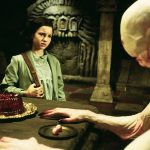Child 44 (2015): In a World Where Murder Doesn’t Exist — A Chilling Descent into Soviet Darkness
Child 44 (2015): In a World Where Murder Doesn’t Exist — A Chilling Descent into Soviet Darkness
In the shadowy corridors of Stalinist Russia, where fear is the national currency and silence is the price of survival, Child 44 unfolds like a slow, suffocating nightmare. Directed by Daniel Espinosa and adapted from Tom Rob Smith’s novel, the 2015 thriller attempts a bold feat: to weave a murder mystery into the fabric of a society where murder officially doesn’t exist. In the USSR of the 1950s, crime is considered a capitalist disease, eradicated under the utopian banner of Soviet ideology.
Yet the truth, dark and festering, cannot be buried. At the center of this grim reality is Leo Demidov, portrayed with muted intensity by Tom Hardy, a loyal agent of the MGB whose devotion to the state begins to crack when confronted with the body of a mutilated child and a government unwilling to admit the killer exists.
Hardy’s portrayal of Leo is not one of a grand hero, but rather of a man conditioned by obedience, forced to reckon with the decay he helped sustain. He speaks little, but each silence is heavy with moral conflict. The slow-burn transformation from a servant of tyranny to a man seeking justice is etched into his expressions, his quiet brooding presence.
Leo’s journey is not a triumphant one, but a descent into truths too dangerous to speak. By his side, or sometimes in opposition, is Noomi Rapace as Raisa, his wife—fearful, enigmatic, emotionally armored. In the beginning, she is a reluctant partner, perhaps even an informant, but as their world collapses and illusions peel away, she reveals herself as a survivor, a woman whose strength is born not of rebellion but of restraint. Rapace delivers a performance of aching complexity, layering vulnerability with flashes of defiance.

The chemistry between Hardy and Rapace is not romantic in the traditional sense, but something more vital—a fragile alliance between two people trying to rediscover trust in a land where trust is lethal. Surrounding them are characters both haunted and haunting. Gary Oldman brings gravitas to General Nesterov, a reluctant ally torn between duty and decency. His grizzled, weary demeanor suggests a man who has seen too much and dared to care too little until now.
Meanwhile, Vincent Cassel is chilling as Major Kuzmin, a man whose loyalty to the regime is less about belief and more about power. He is the embodiment of systemic cruelty: polite, efficient, terrifyingly indifferent. The murders themselves, while grisly, are not the true horror of the film. Rather, it is the refusal of the state to admit they exist that horrifies. Parents are told their children died in accidents, witnesses are silenced, and files are buried. To seek justice is to declare treason. To speak of evil is to become the enemy. In this world, the truth is not just inconvenient—it is dangerous. The film’s visual language mirrors this ideological suffocation.

Bleak, wintry landscapes stretch endlessly under gray skies. The buildings are concrete monoliths, oppressive and drab. Every frame feels cold, not just in temperature but in spirit. The cinematography by Oliver Wood paints Stalin’s Russia not as a location but as a condition—where even light seems reluctant to shine. Daniel Espinosa’s direction resists sensationalism. This is not a film of shootouts or chase scenes. Its pacing is methodical, even glacial, echoing the creeping dread of a society in denial. Some viewers may find this too slow, but patience is rewarded with a narrative that burrows deep into the psychology of fear.
The adaptation does struggle under the weight of its ambition. The accents, while authentic in spirit, occasionally distract. Certain plot elements, especially in the final act, feel compressed or rushed, a likely consequence of fitting a dense novel into a feature-length runtime. And yet, these flaws do not diminish the film’s power—they merely reflect the challenge of capturing such a complex historical moment within the constraints of cinema.

At its core, Child 44 is about the cost of truth. In a society built on lies, where ideology trumps humanity, to uncover a murder is to unmask the regime. The killer may be monstrous, but the system that enables him is far more chilling. The most terrifying thing is not that children are dying—but that their deaths must be erased to protect a myth. This makes Leo’s investigation not just a search for justice but an act of rebellion, a declaration that some truths must be spoken, no matter the cost. The title, Child 44, refers not just to a victim but to a statistic—another name buried, another file closed. It’s a sobering reminder of how systems of control reduce lives to numbers, grief to data. The serial killer, based loosely on the real-life Soviet murderer Andrei Chikatilo, is not the focal point of the story but a symptom of a deeper rot. His evil is real, but the true antagonist is the state’s refusal to confront it. The film ends not with triumph but with survival.

There are no medals, no celebrations, only the quiet knowledge that in a world built on silence, even a whisper of truth is a revolution. It is this emotional and philosophical weight that lingers long after the credits roll. In retrospect, it is no surprise that Child 44 was banned in Russia. Its portrayal of the USSR is not flattering, but neither is it gratuitous. It confronts the darkness without gloating. It tells a story not of Western superiority but of human resilience within an inhuman system.
It does not paint all Soviets as villains—on the contrary, it shows how ordinary people, like Leo and Raisa, are victims of ideology as much as they are participants. This moral ambiguity is what elevates Child 44 beyond mere thriller. It is a study of complicity, courage, and the quiet moments where people decide, against every instinct, to do what is right. It challenges us to ask: What would we risk if truth became a crime? In an era increasingly attuned to surveillance, propaganda, and the erosion of facts, the questions Child 44 poses feel less historical than prophetic.’
It’s not a perfect film, but it is a necessary one—especially for audiences willing to sit with discomfort, to look into the mirror of history and see not just others, but ourselves. Ultimately, Child 44 is a film that haunts. It doesn’t offer easy catharsis or simple heroes. Instead, it demands that we pay attention—to the silence, to the whispers, to the truths we’re told not to speak. It is, like the best political dramas, less about what happens on screen and more about what it awakens in us. And for that, it deserves far more than a passing glance. It deserves to be remembered.










